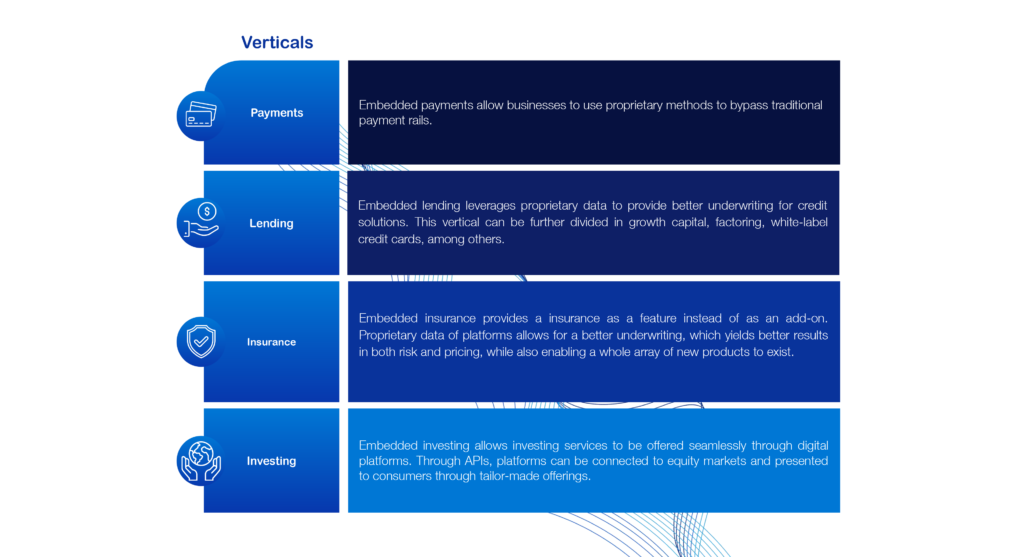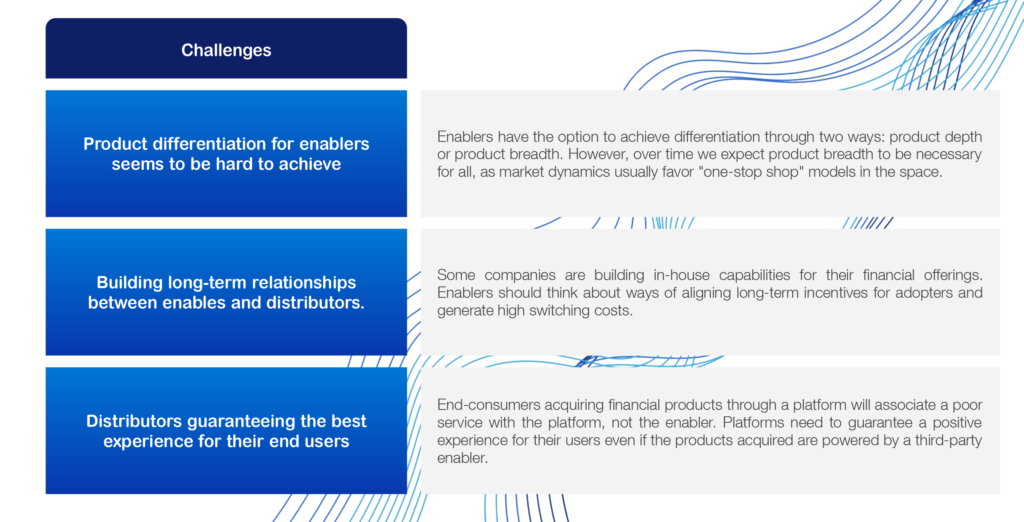Embedded Finance: What is it, and how is Latin America adopting this trend?
by Oscar Peña

The rise of fintech has widely transformed the modern economy. Financial services are being adapted to deliver what end-users need exactly where they want it. Early fintech solutions helped reduce the time and effort required to access financial services, with digitization and speed at the value proposition’s core.
The first wave of fintechs arrived after the 2008 financial crash. It was a natural response to a changing customer and a new set of regulations. Because of new laws, some banking divisions became much less profitable for banks to operate, which opened up a gap for fintechs to fill the inefficiencies by using technology, transforming legacy systems into technology-enabled solutions.¹ Over time, rendering physical branches relatively useless compared to their digital replacements.
According to research done by Redpoint, financial services is the biggest sector with a market cap estimated at USD$16T, while fintech is estimated to have a market cap of less than USD$1.5T². Even though financial services continue to be disrupted at a rapid pace, fintech is still less than 10% of the total value of financial services. At the same time, 40% of the banks are yet to adopt either basic technologies like cloud computing or APIs and 75% have no chatbot customer service. There’s still a long way to go.
With that in mind, we’re now experiencing the second wave of fintech disruption, where until recently, the consumer has had to actively seek out these financial services when a need arises and select from a sea of similar offerings. This has resulted in limited product differentiation and an increase in the cost of acquiring and retaining a customer.
At the same time, next-generation infrastructure players like Stripe and Plaid have emboldened developers to build financial tools.³ These companies have eliminated the complexities of the underlying financial system and have created a new set of companies: Embedded Finance companies.
Embedded finance and embedded fintech are not the same. Embedded fintech is the integration of fintech products and services into large financial institutions enabling better bill negotiation services, subscription management, and investments, among others.
Instead, embedded finance enables non-financial services companies to provide financial solutions such as payments, investing, lending, and insurance for companies with core offerings like marketplaces, vertical SaaS, and e-commerce.
Embedded finance is the integration of financial products tailored to the needs of specific users within platforms that might not be traditionally considered fintech, such as Runa offering SMEs loans for payroll. The financial product is native; it doesn’t redirect to another platform. It should also be a tailored offering for the user, leveraging on as much contextual data as possible to generate a zero-friction experience, with minimum application rejection and no generic offerings (i.e., products that offer “as low as” or “average rate”).
Embedded finance can be divided into a few categories: payments, banking, lending, insurance, brokerage, and credit or debit card issuance. Exploring the current Latam landscape, most companies are being created in the payments, lending, insurance, and investment verticals.

Payments
Embedded payments allow businesses to turn payments from a cost to revenue. Using proprietary methods to bypass traditional payment rails, a SaaS company can serve as the payment provider for their customers. It also creates the possibility of a closed loop ecosystem, where end-consumers are encouraged to stay inside the network, helping to drive loyalty and repeat transactions. An example of a closed loop system is the Starbucks mobile app where, in 2021, customers had USD$1.4 billion in balance, working as a way of pay-now and buy-later while in the meantime, Starbucks can use the outstanding balances as risk-free capital.⁴
In Latin America, Brazilian payment infrastructure fintech Hash offers end-to-end payments for non-financial B2B companies. They’ve identified that traditional payment providers are barely different from one another. In that sense, B2B companies can offer their own payment services to their customers and earn a share of revenue in the process while offering a far better experience through tailored offerings.
Lending
Embedded lending leverages data to provide credit solutions to companies and consumers. This broad vertical can be further divided into three categories: growth capital, factoring, and white-label credit cards.
In the case of growth capital, it enables businesses to access unsecured credit using proprietary underwriting capabilities only available through historical data from the platform. In this space, Mexican startup R2 provides embedded lending infrastructure for Latam. By partnering with B2B companies like Clip and Rappi, this company is able to offer working capital to its partners’ small business clients. Using historical data, they’re able to provide revenue-based financing by leveraging Clip’s payment history or orders through Rappi.
Another example of this is gig-economy companies like Didi and Uber lending to their workers by using proprietary data to make the underwriting. Variables like estimated weekly income and ratings can be used to provide better insight into an underbanked worker, and have a better sense of the risk of a loan. Companies like Prestanómico are working to provide the financial infrastructure that makes this underwriting process possible, while other companies are opting to build it in-house.
Insurance
Embedded insurance provides a way of offering insurance products as a feature of a product, versus it only being an ancillary add-on (such as product warranties or travel insurance). With marketplaces and other platforms being able to access proprietary data, better underwriting methods are developing, yielding better results in both risk and pricing. It also provides a way to offer insurance to underserved categories.
180º Seguros is a Brazilian insurtech company that offers B2B2C insurance services enabling clients to provide coverage for end users. Zul, a parking company based in São Paulo, is able to offer coverage on any belongings left in the vehicle while parking within the platform. Buser is a charter bus company that recently started offering cargo services. Now, they’re able to provide insurance to protect orders from point to point.
Investing
Embedded investing allows any digital company to offer investing services with seamless integrations. They’re primarily API-based companies that connect to the equity markets to add trading functionality to existing platforms, mostly but not exclusively fintechs. In this way, digital wallets, super apps, traditional banks, and insurance platforms, among others, can offer their clients tailored investment instruments to increase their portfolio of products.
Mentum is a San Francisco-based technology company that operates in the fintech space. They provide investment APIs that allow any company in Latam to offer investment services in a digital way. They first launched in Colombia and are now expanding to other countries like Argentina, Chile, and Peru. The interesting thing about them is that the demand for their services is not only coming from fintech companies but also from traditional banks, insurance companies, supermarkets, credit unions, and super apps.
Benefits for SaaS businesses and Platforms
- By adding financial services, SaaS businesses can increase revenue per customer by 2-5x and access markets that weren’t previously accessible due to inefficient customer acquisition.⁵
- By building a vertically integrated service, a SaaS provider can best serve not only software necessities but also the financial solutions that are important for end customers.
- By embedding financial products instead of reselling, platforms gain higher margins, achieve a stickier product, leverage proprietary datasets, and provide a zero-friction customer experience. Some examples of companies doing this are Mecanizou, Nowports, and Morado, among many others.
Challenges in the space
Even though we’re excited about the opportunities in this space for both enablers of technology and adopters, there are some questions that remain to be solved around embedded finance.

- On the enabler side, product differentiation seems to be hard to achieve, as the face of the product to the end user is not the embedded finance company but rather the platform it works on. It’s still early to determine what are those key drivers that will allow a company to scale to the level of legacy institutions.
- Also on the enabler side, what’s the key to building long-term relationships with the platforms that prevents them from building the same product in-house or going to some other enabler that provides them with more revenue share or fewer costs? What prevents Didi from providing in-house loans for their drivers, or Zul from using some other insurance provider for their users? Founders should be thinking in ways of aligning long-term incentives and generating high switching costs.
- For the adopter side, the question remains on how you guarantee the best experience for the end user when the service is not directly provided by your platform? Even though a third party might be providing the financial service, such as what 180º Seguros does through Buser, the end-consumer perceives Buser as the platform though where they bought the service, and might associate a poor service with the overall experience in the platform.
Why are we excited about investing in Embedded Finance?
- The integration of financial services to SaaS and platform business models can drastically improve unit economics and make target markets even bigger while providing financial inclusion. Even though this is a trend that has just recently begun expanding in Latin America, other markets like the US and Europe paint a bright picture for the region. Companies like Etsy, Carvana, Zillow, Toast, and Faire, among many others, already leverage financial products to increase margins. This represents a great case for the possibilities of embedded finance penetrating startups in LATAM.
- The vertical software industry has winner-take-most dynamics. When a SaaS company reaches significant market share, we’re excited about them becoming the best provider for both software and financial services. The case of Toast also becoming the payroll solution for restaurants, making hiring easier and providing them with several paying solutions. Toast also offers eligible customers access to loans from $5,000 to $300,000 as working capital by using proprietary data processed through the Toast ecosystem. The company estimates they have now acquired more than 7% of POS in the US.⁶ These market dynamics are expected to expand in emerging markets like Latin America as infrastructure improves and early movers consolidate.
If you’re currently building an embedded finance company or are adopting one of these solutions within your platform, we’d love to hear from you.
- Cutover. The three waves of fintech
- Medha Agarwal. Redpoint Ventures. What is Fintech and why you should care
- Medha Agarwal. Redpoint Ventures. Embedded Fintech: What is it? (Part I)
- Justin Bariso. Inc Magazine. Starbucks Devised a Brilliant Plan to Borrow Money From Customers
- Kristina Shen et al. Future. Fintech scales vertical SaaS
Maura Webber. CFO Dive. Toast CFO leans into tactical investments for market share

